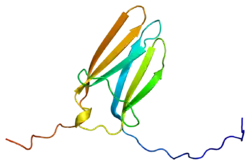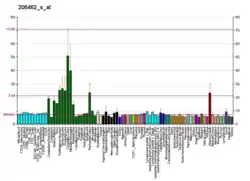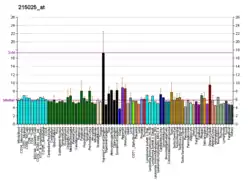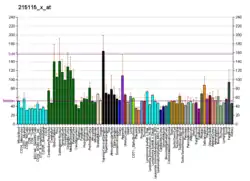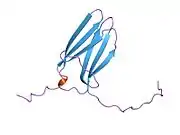Tropomyosin receptor kinase C
Tropomyosin receptor kinase C (TrkC),[5] also known as NT-3 growth factor receptor, neurotrophic tyrosine kinase receptor type 3, or TrkC tyrosine kinase is a protein that in humans is encoded by the NTRK3 gene.[6]
TrkC is the high affinity catalytic receptor for the neurotrophin NT-3 (neurotrophin-3). As such, TrkC mediates the multiple effects of this neurotrophic factor, which includes neuronal differentiation and survival.
The TrkC receptor is part of the large family of receptor tyrosine kinases. A "tyrosine kinase" is an enzyme which is capable of adding a phosphate group to the certain tyrosines on target proteins, or "substrates". A receptor tyrosine kinase is a "tyrosine kinase" which is located at the cellular membrane, and is activated by binding of a ligand via its extracellular domain. Other example of tyrosine kinase receptors include the insulin receptor, the IGF-1 receptor, the MuSK protein receptor, the vascular endothelial growth factor (VEGF) receptor, etc. The "substrate" proteins which are phosphorylated by TrkC include PI3 kinase.
Family members
TrkC is part of a sub-family of protein kinases which includes TrkA and TrkB. Also, there are other neurotrophic factors structurally related to NT-3: NGF (for Nerve Growth Factor), BDNF (for Brain Derived Neurotrophic Factor) and NT-4 (for Neurotrophin-4). While TrkB mediates the effects of BDNF, NT-4 and NT-3, TrkA is bound and thereby activated only by NGF. Further, TrkC binds and is activated only by NT-3.
TrkB binds BDNF and NT-4 more strongly than it binds NT-3. TrkC binds NT-3 more strongly than TrkB does.
Receptor
There is one other NT-3 receptor family besides the Trks (TrkC & TrkB), called the "LNGFR" (for "low affinity nerve growth factor receptor"). As opposed to TrkC, the LNGFR plays a somewhat less clear role in NT-3 biology. Some researchers have shown the LNGFR binds and serves as a "sink" for neurotrophins. Cells which express both the LNGFR and the Trk receptors might therefore have a greater activity - since they have a higher "microconcentration" of the neurotrophin. It has also been shown, however, that the LNGFR may signal a cell to die via apoptosis - so therefore cells expressing the LNGFR in the absence of Trk receptors may die rather than live in the presence of a neurotrophin.
It has been demonstrated that NTRK3 is a dependence receptor, meaning that it can be capable of inducing proliferation when it binds to its ligand NT-3, however, the absence of the NT-3 will result in the induction of apoptosis by NTRK3.[7]
Role in cancer
Although originally identified as an oncogenic fusion in 1982,[8] only recently has there been a renewed interest in the Trk family as it relates to its role in human cancers because of the identification of NTRK1 (TrkA), NTRK2 (TrkB) and NTRK3 (TrkC) gene fusions and other oncogenic alterations in a number of tumor types. A number of Trk inhibitors are (in 2015) in clinical trials and have shown early promise in shrinking human tumors.[9] Family of neurotrophin receptors including NTRK3 have been shown to induce a variety of pleiotorpic response in malignant cells, including enhanced tumor cell invasiveness and chemotoxis.[10] Increased NTRK3 expression has been demonstrated in neuroblastoma,[11] in medulloblastoma,[12] and in neuroectodermal brain tumors.[13]
NTRK3 methylation
The promoter region of NTRK3 contains a dense CpG island located relatively adjacent to the transcription start site (TSS). Using HumanMethylation450 arrays, quantitative methylation-specific PCR (qMSP), and Methylight assays, it has been indicated that NTRK3 is methylated in all CRC cell lines and non of the normal epithelium samples. In light of its preferential methylation in CRCs and because of its role as a neurotrophin receptor, it has been suggested to have a functional role in colorectal cancer formation.[14] It has also been suggested that methylation status of NTRK3 promoter is capable of discriminating CRC tumor samples from normal adjacent tumor-free tissue. Hence it can be considered as a biomarker for molecular detection of CRC, specially in combination with other markers like SEPT9.[15] NTRK3 has also been indicated as one of the genes in the panel of nine CpG methylation probes located at promoter or exon 1 region of eight genes (including DDIT3, FES, FLT3, SEPT5, SEPT9, SOX1, SOX17, and NTRK3) for prognostic prediction in ESCC (esophageal squamous cell carcinoma) patients.[16]
TrkC (NTRK3 gene) inhibitors in development
Entrectinib (formerly RXDX-101) is an investigational drug developed by Ignyta, Inc., which has potential antitumor activity. It is a selective pan-trk receptor tyrosine kinase inhibitor (TKI) targeting gene fusions in trkA, trkB, and trkC (coded by NTRK1, NTRK2, and NTRK3 genes) that is currently in phase 2 clinical testing.[17]
References
- GRCh38: Ensembl release 89: ENSG00000140538 - Ensembl, May 2017
- GRCm38: Ensembl release 89: ENSMUSG00000059146 - Ensembl, May 2017
- "Human PubMed Reference:". National Center for Biotechnology Information, U.S. National Library of Medicine.
- "Mouse PubMed Reference:". National Center for Biotechnology Information, U.S. National Library of Medicine.
- Malenka RC, Nestler EJ, Hyman SE (2009). "Chapter 8: Atypical neurotransmitters". In Sydor A, Brown RY (eds.). Molecular Neuropharmacology: A Foundation for Clinical Neuroscience (2nd ed.). New York: McGraw-Hill Medical. ISBN 978-0-07-148127-4.
Another common feature of neurotrophins is that they produce their physiologic effects by means of the tropomyosin receptor kinase (Trk) receptor family (also known as the tyrosine receptor kinase family). ... Try receptors. All neurotrophins bind to a class of highly homologous receptor tyrosine kinases known as Trk receptors, of which three types are known: TrkA, TrkB, and TrkC. These transmembrane receptors are glycoproteins whose molecular masses range from 140 to 145 kDa. Each type of Trk receptor tends to bind specific neurotrophins: TrkA is the receptor for NGF, TrkB the receptor for BDNF and NT-4, and TrkC the receptor for NT-3.However, some overlap in the specificity of these receptors has been noted.
- McGregor LM, Baylin SB, Griffin CA, Hawkins AL, Nelkin BD (July 1994). "Molecular cloning of the cDNA for human TrkC (NTRK3), chromosomal assignment, and evidence for a splice variant". Genomics. 22 (2): 267–72. doi:10.1006/geno.1994.1383. PMID 7806211.
- Bouzas-Rodriguez J, Cabrera JR, Delloye-Bourgeois C, Ichim G, Delcros JG, Raquin MA, et al. (March 2010). "Neurotrophin-3 production promotes human neuroblastoma cell survival by inhibiting TrkC-induced apoptosis". The Journal of Clinical Investigation. 120 (3): 850–8. doi:10.1172/jci41013. PMC 2827960. PMID 20160348.
- Pulciani S, Santos E, Lauver AV, Long LK, Aaronson SA, Barbacid M (December 1982). "Oncogenes in solid human tumours". Nature. 300 (5892): 539–42. Bibcode:1982Natur.300..539P. doi:10.1038/300539a0. PMID 7144906.
- Doebele RC, Davis LE, Vaishnavi A, Le AT, Estrada-Bernal A, Keysar S, et al. (October 2015). "An Oncogenic NTRK Fusion in a Patient with Soft-Tissue Sarcoma with Response to the Tropomyosin-Related Kinase Inhibitor LOXO-101". Cancer Discovery. 5 (10): 1049–57. doi:10.1158/2159-8290.CD-15-0443. PMC 4635026. PMID 26216294.
- Jin W, Kim GM, Kim MS, Lim MH, Yun C, Jeong J, et al. (November 2010). "TrkC plays an essential role in breast tumor growth and metastasis". Carcinogenesis. 31 (11): 1939–47. doi:10.1093/carcin/bgq180. PMID 20802235.
- Brodeur GM, Minturn JE, Ho R, Simpson AM, Iyer R, Varela CR, et al. (May 2009). "Trk receptor expression and inhibition in neuroblastomas". Clinical Cancer Research. 15 (10): 3244–50. doi:10.1158/1078-0432.ccr-08-1815. PMC 4238907. PMID 19417027.
- Huong LD, Shin JA, Choi ES, Cho NP, Kim HM, Leem DH, Cho SD (July 2012). "β-Phenethyl isothiocyanate induces death receptor 5 to induce apoptosis in human oral cancer cells via p38". Oral Diseases. 18 (5): 513–9. doi:10.1111/j.1601-0825.2012.01905.x. PMID 22309674.
- Grotzer MA, Janss AJ, Fung K, Biegel JA, Sutton LN, Rorke LB, et al. (March 2000). "TrkC expression predicts good clinical outcome in primitive neuroectodermal brain tumors". Journal of Clinical Oncology. 18 (5): 1027–35. doi:10.1200/jco.2000.18.5.1027. PMID 10694553.
- Luo Y, Kaz AM, Kanngurn S, Welsch P, Morris SM, Wang J, et al. (2013-07-11). "NTRK3 is a potential tumor suppressor gene commonly inactivated by epigenetic mechanisms in colorectal cancer". PLoS Genetics. 9 (7): e1003552. doi:10.1371/journal.pgen.1003552. PMC 3708790. PMID 23874207.
- Behrouz Sharif S, Hashemzadeh S, Mousavi Ardehaie R, Eftekharsadat A, Ghojazadeh M, Mehrtash AH, et al. (December 2016). "Detection of aberrant methylated SEPT9 and NTRK3 genes in sporadic colorectal cancer patients as a potential diagnostic biomarker". Oncology Letters. 12 (6): 5335–5343. doi:10.3892/ol.2016.5327. PMC 5228494. PMID 28105243.
- Kuo IY, Chang JM, Jiang SS, Chen CH, Chang IS, Sheu BS, et al. (2014). "Prognostic CpG methylation biomarkers identified by methylation array in esophageal squamous cell carcinoma patients". International Journal of Medical Sciences. 11 (8): 779–87. doi:10.7150/ijms.7405. PMC 4057483. PMID 24936140.
- "Promising entrectinib clinical trial data". ScienceDaily. 18 April 2016.
Further reading
- Lamballe F, Klein R, Barbacid M (September 1991). "trkC, a new member of the trk family of tyrosine protein kinases, is a receptor for neurotrophin-3". Cell. 66 (5): 967–79. doi:10.1016/0092-8674(91)90442-2. PMID 1653651.
- Tessarollo L, Tsoulfas P, Martin-Zanca D, Gilbert DJ, Jenkins NA, Copeland NG, Parada LF (June 1993). "trkC, a receptor for neurotrophin-3, is widely expressed in the developing nervous system and in non-neuronal tissues". Development. 118 (2): 463–75. PMID 8223273.
- Klein R, Silos-Santiago I, Smeyne RJ, Lira SA, Brambilla R, Bryant S, et al. (March 1994). "Disruption of the neurotrophin-3 receptor gene trkC eliminates la muscle afferents and results in abnormal movements". Nature. 368 (6468): 249–51. Bibcode:1994Natur.368..249K. doi:10.1038/368249a0. PMID 8145824.
- Ip NY, Stitt TN, Tapley P, Klein R, Glass DJ, Fandl J, et al. (February 1993). "Similarities and differences in the way neurotrophins interact with the Trk receptors in neuronal and nonneuronal cells". Neuron. 10 (2): 137–49. doi:10.1016/0896-6273(93)90306-C. PMID 7679912.
- Ebendal T (August 1992). "Function and evolution in the NGF family and its receptors". Journal of Neuroscience Research. 32 (4): 461–70. doi:10.1002/jnr.490320402. PMID 1326636.
- Guiton M, Gunn-Moore FJ, Glass DJ, Geis DR, Yancopoulos GD, Tavaré JM (September 1995). "Naturally occurring tyrosine kinase inserts block high affinity binding of phospholipase C gamma and Shc to TrkC and neurotrophin-3 signaling". The Journal of Biological Chemistry. 270 (35): 20384–90. doi:10.1074/jbc.270.35.20384. PMID 7657612.
- Shelton DL, Sutherland J, Gripp J, Camerato T, Armanini MP, Phillips HS, et al. (January 1995). "Human trks: molecular cloning, tissue distribution, and expression of extracellular domain immunoadhesins". The Journal of Neuroscience. 15 (1 Pt 2): 477–91. doi:10.1523/JNEUROSCI.15-01-00477.1995. PMC 6578290. PMID 7823156.
- Pflug BR, Dionne C, Kaplan DR, Lynch J, Djakiew D (January 1995). "Expression of a Trk high affinity nerve growth factor receptor in the human prostate". Endocrinology. 136 (1): 262–8. doi:10.1210/en.136.1.262. PMID 7828539.
- Lamballe F, Tapley P, Barbacid M (August 1993). "trkC encodes multiple neurotrophin-3 receptors with distinct biological properties and substrate specificities". The EMBO Journal. 12 (8): 3083–94. doi:10.1002/j.1460-2075.1993.tb05977.x. PMC 413573. PMID 8344249.
- Andersson B, Wentland MA, Ricafrente JY, Liu W, Gibbs RA (April 1996). "A "double adaptor" method for improved shotgun library construction". Analytical Biochemistry. 236 (1): 107–13. doi:10.1006/abio.1996.0138. PMID 8619474.
- Yamamoto M, Sobue G, Yamamoto K, Terao S, Mitsuma T (August 1996). "Expression of mRNAs for neurotrophic factors (NGF, BDNF, NT-3, and GDNF) and their receptors (p75NGFR, trkA, trkB, and trkC) in the adult human peripheral nervous system and nonneural tissues". Neurochemical Research. 21 (8): 929–38. doi:10.1007/BF02532343. PMID 8895847.
- Yu W, Andersson B, Worley KC, Muzny DM, Ding Y, Liu W, et al. (April 1997). "Large-scale concatenation cDNA sequencing". Genome Research. 7 (4): 353–8. doi:10.1101/gr.7.4.353. PMC 139146. PMID 9110174.
- Valent A, Danglot G, Bernheim A (1997). "Mapping of the tyrosine kinase receptors trkA (NTRK1), trkB (NTRK2) and trkC(NTRK3) to human chromosomes 1q22, 9q22 and 15q25 by fluorescence in situ hybridization". European Journal of Human Genetics. 5 (2): 102–4. doi:10.1159/000484742. PMID 9195161.
- Terenghi G, Mann D, Kopelman PG, Anand P (May 1997). "trkA and trkC expression is increased in human diabetic skin". Neuroscience Letters. 228 (1): 33–6. doi:10.1016/S0304-3940(97)00350-9. PMID 9197281.
- Knezevich SR, McFadden DE, Tao W, Lim JF, Sorensen PH (February 1998). "A novel ETV6-NTRK3 gene fusion in congenital fibrosarcoma". Nature Genetics. 18 (2): 184–7. doi:10.1038/ng0298-184. PMID 9462753.
- Urfer R, Tsoulfas P, O'Connell L, Hongo JA, Zhao W, Presta LG (March 1998). "High resolution mapping of the binding site of TrkA for nerve growth factor and TrkC for neurotrophin-3 on the second immunoglobulin-like domain of the Trk receptors". The Journal of Biological Chemistry. 273 (10): 5829–40. doi:10.1074/jbc.273.10.5829. PMID 9488719.
- Hu YQ, Koo PH (July 1998). "Inhibition of phosphorylation of TrkB and TrkC and their signal transduction by alpha2-macroglobulin". Journal of Neurochemistry. 71 (1): 213–20. doi:10.1046/j.1471-4159.1998.71010213.x. PMID 9648868.
- Ichaso N, Rodriguez RE, Martin-Zanca D, Gonzalez-Sarmiento R (October 1998). "Genomic characterization of the human trkC gene". Oncogene. 17 (14): 1871–5. doi:10.1038/sj.onc.1202100. PMID 9778053.
- Qian X, Riccio A, Zhang Y, Ginty DD (November 1998). "Identification and characterization of novel substrates of Trk receptors in developing neurons". Neuron. 21 (5): 1017–29. doi:10.1016/S0896-6273(00)80620-0. PMID 9856458.
- Bibel M, Hoppe E, Barde YA (February 1999). "Biochemical and functional interactions between the neurotrophin receptors trk and p75NTR". The EMBO Journal. 18 (3): 616–22. doi:10.1093/emboj/18.3.616. PMC 1171154. PMID 9927421.
- Labouyrie E, Dubus P, Groppi A, Mahon FX, Ferrer J, Parrens M, et al. (February 1999). "Expression of neurotrophins and their receptors in human bone marrow". The American Journal of Pathology. 154 (2): 405–15. doi:10.1016/s0002-9440(10)65287-x. PMC 1849993. PMID 10027399.
